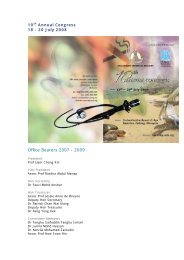download - Malaysian Thoracic Society
download - Malaysian Thoracic Society
download - Malaysian Thoracic Society
You also want an ePaper? Increase the reach of your titles
YUMPU automatically turns print PDFs into web optimized ePapers that Google loves.
Annual Congress of <strong>Malaysian</strong> <strong>Thoracic</strong> <strong>Society</strong><br />
Symposium 1C<br />
Paediatric Asthma<br />
Doctor, Doctor, what will happen to my child’s asthma?<br />
Theresa Guilbert<br />
USA<br />
Parents of infants and young children with recurrent wheezing often ask “Does my child have asthma?”<br />
This is a question that clinicians involved in patient care, and also those researching asthma, would like to be<br />
able to answer. Preschool wheezing, a symptom that can herald the subsequent development of childhood<br />
asthma, is a common problem worldwide. However, the condition improves and ultimately disappears by<br />
school years in many children. Proper identification of infants and young children at increased risk to develop<br />
persistent asthma may help predict long-term outcomes and improve prevention and treatment, but the ability<br />
to identify these children remains limited.<br />
Several classifications of wheezing phenotypes and other tools have been developed in an effort to categorize<br />
children with recurrent wheezing and determine which will ultimately develop asthma. These wheezing<br />
phenotypes and predictive tools are reviewed in this lecture. Almost 50 percent of children are reported to<br />
have wheezing in the first year of life, although only 20 percent will experience continued wheezing symptoms<br />
in later childhood. Wheezing phenotypes have been defined to identify the characteristics and risk factors<br />
associated with children that experience wheezing. Some of these phenotypes describe children who continue<br />
to wheeze until later childhood, while others identify those who continue to wheeze through adolescence and<br />
adulthood. However, the relationship between risk factors and the subsequent development of asthma in later<br />
childhood and adult life is not clear.<br />
Identifying phenotypes of pediatric asthma may help predict long-term outcomes and identify high-risk children<br />
who might benefit from secondary prevention interventions. Although conventional diagnostic evaluation and<br />
clinical indices (e.g., Asthma Predictive Index) can be useful, future tests (e.g., genetic evaluations, exhaled<br />
nitric oxide,, interferon g) may further assist practitioners in discriminating between various phenotypes of<br />
wheezing.<br />
Lunch Satellite Symposium<br />
(Novartis)<br />
Current Treatment of COPD<br />
Philip Eng<br />
Singapore<br />
The burden of COPD continues to increase all over the world. Fortunately, this has been accompanied by<br />
a slew of new drugs for the treatment of COPD. All of these drugs have been backed by mega trials which<br />
have better clarified their efficacy and adverse effects. In this presentation, I will attempt to give an overview<br />
of the current treatment of COPD.<br />
21








